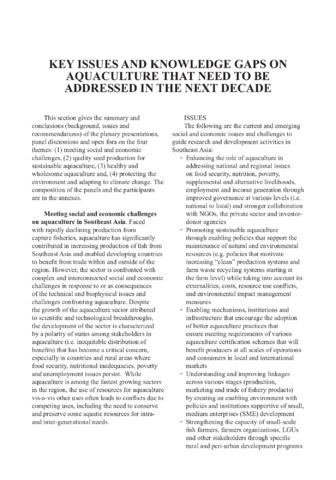Key issues and knowledge gaps on aquaculture that need to be addressed in the next decade
Share
Abstract
This section gives the summary and conclusions (background, issues and recommendations) of the plenary presentations, panel discussions and open fora on the four themes: (1) meeting social and economic challenges, (2) quality seed production for sustainable aquaculture, (3) healthy and wholesome aquaculture and, (4) protecting the environment and adapting to climate change.
Suggested Citation
Acosta, B. O., Coloso, R. M., de Jesus-Ayson, E. G. T., & Toledo, J. D. (Eds.). (2011). Key issues and knowledge gaps on aquaculture that need to be addressed in the next decade. In Sustainable aquaculture development for food security in Southeast Asia towards 2020. Proceedings of the Regional Technical Consultation on Sustainable Aquaculture Development in Southeast Asia Towards 2020 (pp. 53–60). Tigbauan, Iloilo, Philippines: Aquaculture Department, Southeast Asian Fisheries Development Center.
Subject
aquaculture  ; aquaculture development
; aquaculture development  ; aquaculture economics
; aquaculture economics  ; aquaculture regulations
; aquaculture regulations  ; breeding
; breeding  ; certification
; certification  ; Climatic changes; culture effects
; Climatic changes; culture effects  ; environmental impact
; environmental impact  ; feeds
; feeds  ; fish diseases
; fish diseases  ; Fish meal; food security
; Fish meal; food security  ; regional planning
; regional planning  ; seed (aquaculture)
; seed (aquaculture)  ; socioeconomic aspects
; socioeconomic aspects  ; sustainability
; sustainability  ; South East Asia
; South East Asia
 ; aquaculture development
; aquaculture development  ; aquaculture economics
; aquaculture economics  ; aquaculture regulations
; aquaculture regulations  ; breeding
; breeding  ; certification
; certification  ; Climatic changes; culture effects
; Climatic changes; culture effects  ; environmental impact
; environmental impact  ; feeds
; feeds  ; fish diseases
; fish diseases  ; Fish meal; food security
; Fish meal; food security  ; regional planning
; regional planning  ; seed (aquaculture)
; seed (aquaculture)  ; socioeconomic aspects
; socioeconomic aspects  ; sustainability
; sustainability  ; South East Asia
; South East Asia
Related items
Showing items related by title, author, creator and subject.
-
Family farms in Vietnam
Aldon, Eva T. (Aquaculture Department, Southeast Asian Fisheries Development Center, 1997) -
The Philippine aquaculture industry
Camacho, Arsenio S.; Macalincag-Lagua, Natividad (Aquaculture Department, Southeast Asian Fisheries Development Center, 1988)The aquaculture sector of the Philippine fishing industry registered the highest growth rate of 12.5% in 1977-1986. The contribution of aquaculture to the total fish production was equivalent to 24% in 1986 compared to ... -
Knowing Asian aquaculture and fisheries
Surtida, Marilyn B. (Aquaculture Department, Southeast Asian Fisheries Development Center, 1998-04)This article is the second of four parts.




